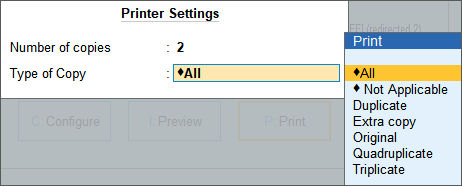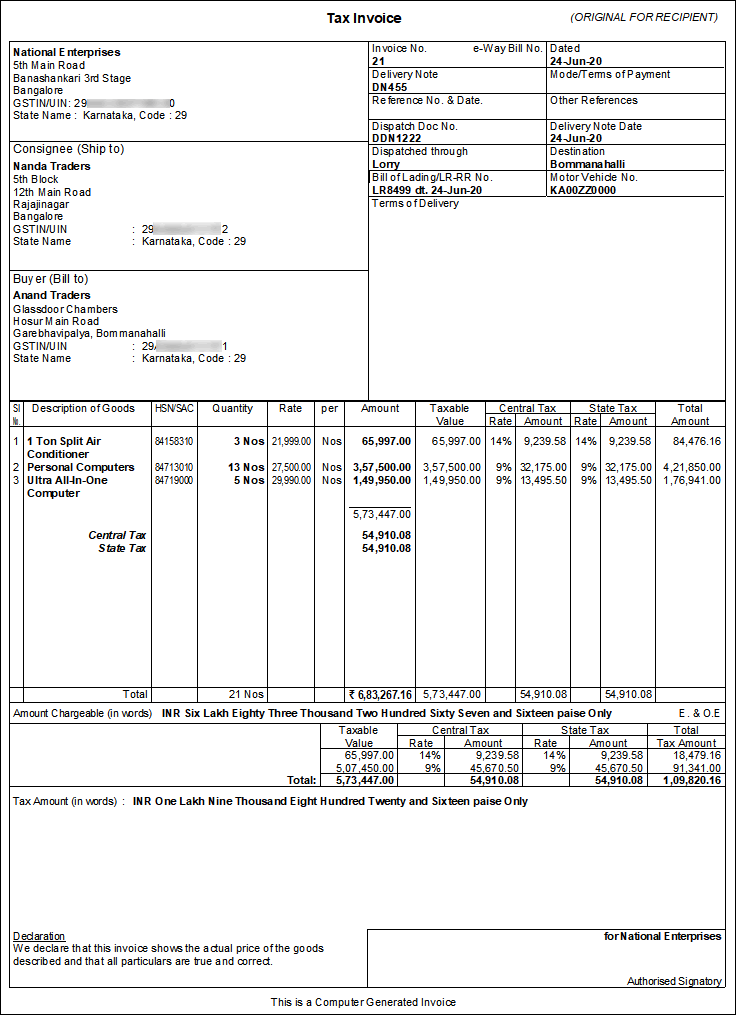Purchase and Sale Entry with GST in tally prime 2023: In purchase and Sale entry, whether cash or credit, the procedure in TallyPrime remains similar. The only difference is a user has to select some money or bank for cash purchases or sales and the supplier ledger for credit purchases or sales. In this article, we will discuss in detail the purchase and sale entry with GST in tally prime 2023.
Purchase and Sale Entry with GST in Tally
Pass Purchase entry: Once the company has activated GST, they can record the purchase of goods and services (inward supply) that attract GST using a purchase voucher. TallyPrime provides the user with the flexibility to use the different invoice modes interchangeably for recording purchases.
Accountant records purchasing of items using Item invoice mode and purchase without items in Accounting Invoice mode. A user can also print the invoices with the necessary details if needed.
To record purchase entry with GST, follow the steps mentioned below:
- Go to Gateway of Tally > Select Vouchers > press F9 to open the (Purchase) screen. Or you can also press Alt+G (Go To) > Create Voucher > press F9 (Purchase).
- Now PressCtrl+H(Change Mode) to select the required voucher mode (Item Invoice)
To pass Purchase entry with GST:Select the shared purchase ledger during the transaction. You can Press F12 (Configure) to set the option“Modify Tax Rate details for GST” to Yes.Select the Classification/Nature.

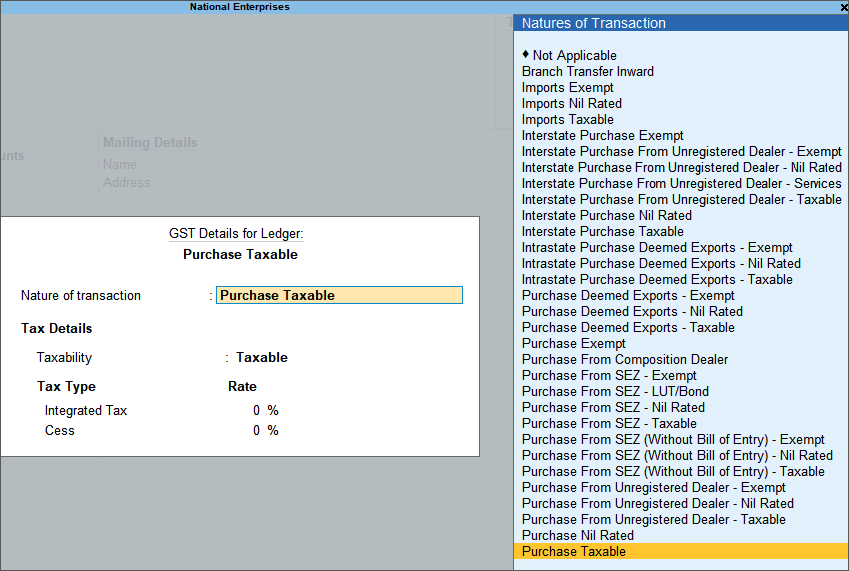
- Specify the supplier details in purchase and sale entry, for example:
- Supplier Invoice No.andDate: The invoice number and date will be the same as the sales bill.
- Party A/c name: You have to Select the Cash or Bank for cash purchases. For credit purchases, select the supplier ledger.
- Select the common purchase ledger in which GST rate is not defined.
- Select the stock items defined with different GST rates, and specify the quantities and rates for each of them.
- Party Details: After supplier details, Enter the supplier’s name and address, if needed.
- PressF12(Configure) if you do not see theParty Detailsscreen and setProvide Receipt, Order, and Import detailstoYes.
- Select the central and state tax ledgers. GST will be calculated based on the GST rates defined in the stock items.
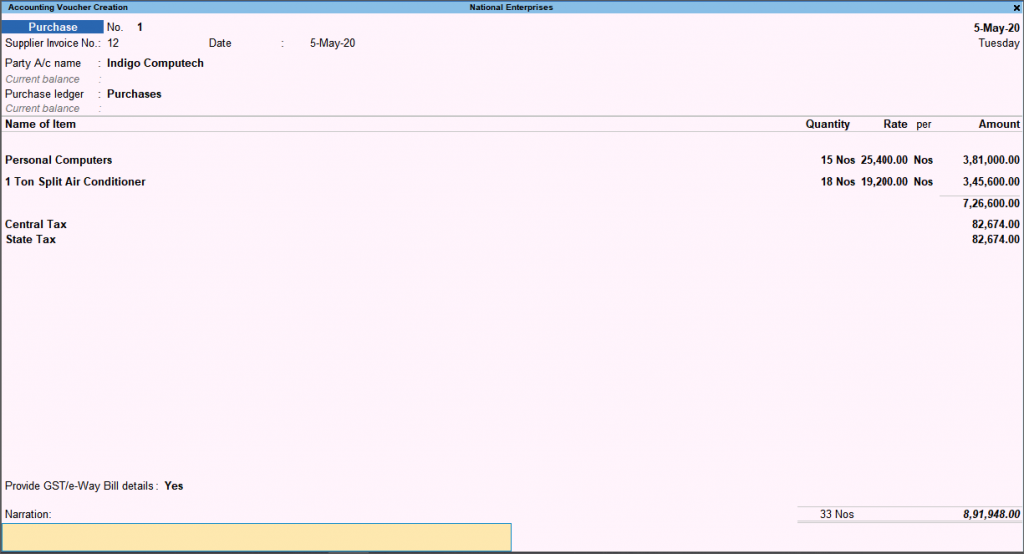
Note:If you want to enter specific details about the suppliers in purchase and sale entry, such as address with a landmark, alternative contact number, etc., in the invoices. Then, you can create party ledgers with the required details. In theSuppliersfield andgt;Party Detailsscreenandgt; select the necessary ledger.
- Purchase ledger: Select the accounting ledger to allocate the stock items.
Advertisement
PressF12(Configure) if you do not see the purchase field on the screen, and setSelect “common Ledger Account for Item Allocation”toYes.
- Now go toAccounting Invoice andgt;select purchase ledger underParticulars
- Provide the stock item or service details.
A user can also create the item or ledger while passing the entry by pressingAlt+C.
- In Item Invoice, select the stock item and enter theQuantity. The Rate will be auto-filled if available for the stock item. Or you can enter the Amount or Quantity.
- In Accounting Invoice, select the service ledger and enter theAmount.
- Select additional ledgers, like transportation charges, insurance, or discount, if any.
- Now you can ProvideNarrationif needed
- Accept the screen. Or, to save, you can pressCtrl+A.
- PressCtrl+I(More Details) andgt; type or selectGST – Tax Analysisto view the tax details. PressAlt+F5(Detailed) to view the detailed break-up of tax.

To Print the purchase invoice created:
- First, Press Alt+P (Print) andgt; press Enter.
- Now Press I (Preview) to check the invoice details before printing if needed.
- At last, you can Press P (Print) to print.
- The print of invoice in Purchase and sale entry remains the same in GST tally prime.
Purchase and Sale Entry with GST in Tally
Sales Entry with GST: To record sales of goods, A user select cash or bank for cash sales and a party ledger for credit sales. A user can record sales of goods or items in the Item Invoice mode. TallyPrime different features provide other ways, such as Accounting Invoice mode and Voucher mode, to record sales of goods or services. Based on their requirement, an accountant uses the different methods of the voucher interchangeably for recording sales transactions.
A user records sales under GST and prints a valid GST tax invoice with the party’s GST registration and location, item details (HSN or SAC), and tax rates.
To record sales transactions with GST in tally, follow the steps mentioned below:
- Go to Gateway of Tally> Select Vouchers > Press F8 to record (Sales) voucher. Or you can press Alt+G(Go To) > Create Voucher > press F8 (Sales).
- Press Ctrl+H(Change Mode) to ensure that the voucher mode is set toItem Invoicemode. A user can confirm the same if they seethe Name of the Itemon the voucher screen.
- You can also enter thereference numberandDatefor the invoice by pressingF12(Configure) and setting “Provide Reference No. and Date”toYes.
- PressF12(Configure) andgt; set the optionModify Tax Rate details for GSTtoYes. Select theClassification/Nature.
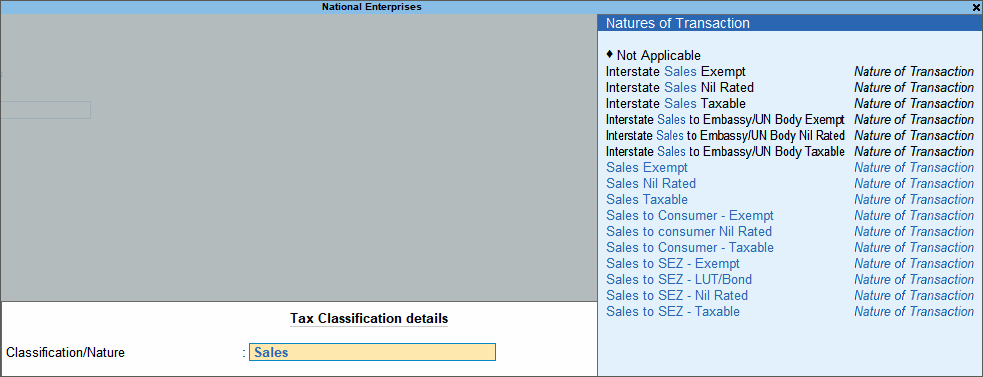
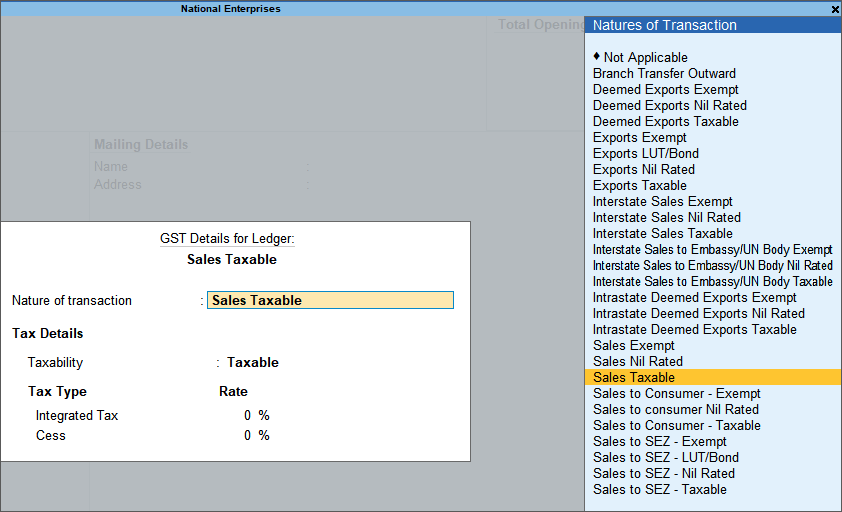
However, If you do not see this option, set “Show more configurations”toYes.
- Now Specify the buyer details in purchase and sale entry with the following information:
- Enter the Party A/c name: You need to Select theCashorBankoption while passing the cash sales transaction. If there are credit sales, then select the party name.
- Party Details: ToDispatch,Order, orBuyerdetails to be part of your invoice, provide the relevant information.
- Select the stock items defined with different GST rates, and specify their quantities and rates separately.
- Now you need to Select the central and state tax ledgers. GST will be automatically calculated based on the GST rates defined in the stock items.
PressF12(Configure) if unable to see theParty Detailsscreen and set or turn “Provide Dispatch, Order, and Export details”toYes.
- Enter the Dispatch and Order Details: You can also print these details in the invoice for the buyers or future reference by entering these details. However, if you already have a Delivery Note or a Sales Order, it will be pre-filled as a delivery number or sales number.
- Buyer’s Details: In cash sales, specify the buyer’s details.
Note:The regular customers of a business may need specific details, such as address with a landmark, alternative contact number, and so on, to appear in the invoices they receive. In such cases, one creates party ledgers with the required details, such as Address, State, etc.
- In theBuyersfield, select the necessary ledger.
- As always, you can pressCtrl+Ato save and proceed.
- Select the accounting ledger to allocate the stock items.
- ForItem Invoice, select theSalesledger.
- If you do not see this field on the screen, press F12 (Configure) and select“common Ledger Account for Item Allocation” to Yes.
- However, you need to set this option asNoto allocate the sale of each item to different accounting ledgers.
- Provide stock item details.
You can also create the item or ledger while passing the entry by pressingAlt+C.
- To pass entry ForItem Invoice, select the stock item, enter theQuantity. TheRatewill be auto-filled if available for the stock item. Or enter the amount by yourself.
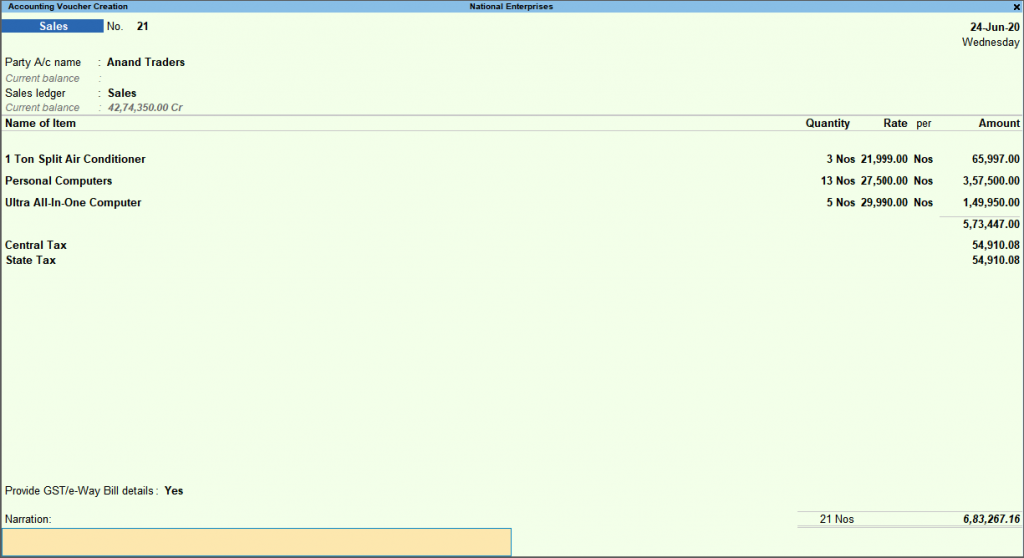
PressCtrl+Oandgt; type or selectGST – Tax Analysisto view the tax details. PressAlt+F5 (Detailed)to view the detailed break-up of tax.
- You can Select the additional ledgers in purchase and sale entry for transportation charges, insurance, or discount.
- At last, ProvideNarration.
- Accept the screen. Or, to save, you can pressCtrl+A.

To Print the sale invoice, follow the below-mentioned steps:
- First, select the invoice you want to print and pressCtrl+P. Or you can pressAlt+P(Print) andgt; pressEnteronCurrent.
- You can Press C(Configure) to configure the print options for your invoice.
- PressC(Configure) andgt; type or selectPrinterandgt; and pressEnterto change the printer setting.
- To print multiple copies of the invoice, select and provideNumber of Copiesandgt; type or selectType of Copy.
- PressI(Preview) to check the invoice details before printing.
- At last, PressP(Print) to print the purchase and sale entry invoices..
Recommended


